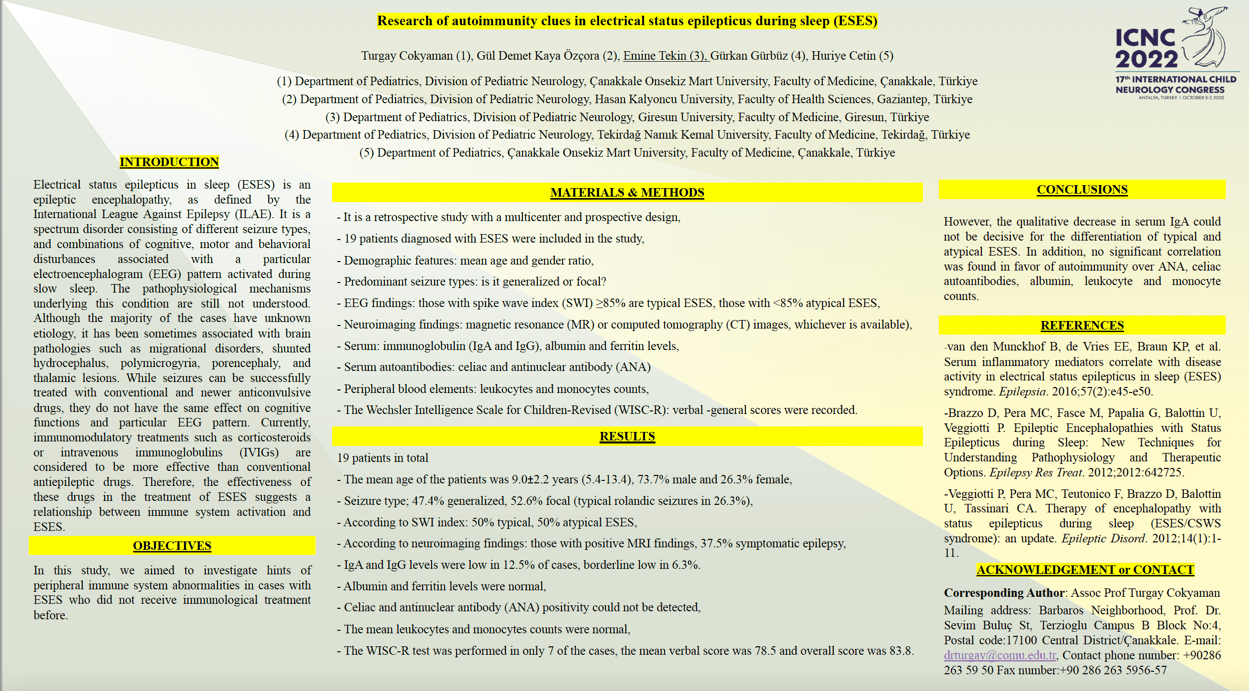Research of autoimmunity clues in electrical status epilepticus (ESES) during sleep
Turgay Cokyaman, Gül Demet Kaya Özçora, Emine Tekin, Gürkan Gürbüz, Huriye Cetin
Objective:The use of drugs such as IVIG, corticosteroids and ACTH in the treatment of ESES points to immunological mechanisms in its etiopathology. In this study, we aimed to investigate autoimmunity clues in cases with ESES who did not receive immunological treatment before. Methods:19 patients with a diagnosis of ESES were included in this multicenter and retrospective study. Demographic features, predominant seizure types and given antiepileptics, electroencephalogram (EEG) and neuroimaging (MRI) findings, serum immunoglobulin levels, celiac autoantibodies, antinuclear antibody (ANA), albumin and ferritin levels, peripheral blood leukocytes and monocytes counts, WISC-R verbal -general scores and thyroid function tests were recorded. Results:The mean age of the patients was 9.0±2.2 years (5.4-13.4), 73.7% male and 26.3% female, 50% typical and 50% atypical ESES. The ESES pattern was in the frontocentral and anterior temporal brain regions in 88.9% of the cases. Mostly seizure type was generalized in 47.4%, focal in 26.3%, and typical rolandic seizures in 26.3%. According to brain MRI findings, 37.5% (6) were symptomatic. IgA and IgG levels were low in 12.5% of cases, borderline low in 6.3%. Albumin levels, and the mean leukocyte and monocyte counts were normal. The WISC-R test was performed in only 7 of the cases, the mean verbal score was 78.5 and overall score was 83.8. Discussion:However, the qualitative decrease in serum IgA could not be decisive for the differentiation of typical and atypical ESES. In addition, no significant correlation was found in favor of autoimmunity over ANA, celiac autoantibodies, thyroid tests, albumin, leukocyte and monocyte counts.
Keywords: electrical status epilepticus, sleep, autoimmunity, children
Turgay Cokyaman
Çanakkale Onsekiz Mart University, Faculty of Medicine
Turkey
Gül Demet Kaya Özçora
Hasan Kalyoncu University, Faculty of Health Sciences
Turkey
Emine Tekin
Giresun University, Faculty of Medicine
Turkey
Gürkan Gürbüz
Tekirdağ Namık Kemal University, Faculty of Medicine
Turkey
Huriye Cetin
Çanakkale Onsekiz Mart University, Faculty of Medicine
Turkey
Objective:The use of drugs such as IVIG, corticosteroids and ACTH in the treatment of ESES points to immunological mechanisms in its etiopathology. In this study, we aimed to investigate autoimmunity clues in cases with ESES who did not receive immunological treatment before. Methods:19 patients with a diagnosis of ESES were included in this multicenter and retrospective study. Demographic features, predominant seizure types and given antiepileptics, electroencephalogram (EEG) and neuroimaging (MRI) findings, serum immunoglobulin levels, celiac autoantibodies, antinuclear antibody (ANA), albumin and ferritin levels, peripheral blood leukocytes and monocytes counts, WISC-R verbal -general scores and thyroid function tests were recorded. Results:The mean age of the patients was 9.0±2.2 years (5.4-13.4), 73.7% male and 26.3% female, 50% typical and 50% atypical ESES. The ESES pattern was in the frontocentral and anterior temporal brain regions in 88.9% of the cases. Mostly seizure type was generalized in 47.4%, focal in 26.3%, and typical rolandic seizures in 26.3%. According to brain MRI findings, 37.5% (6) were symptomatic. IgA and IgG levels were low in 12.5% of cases, borderline low in 6.3%. Albumin levels, and the mean leukocyte and monocyte counts were normal. The WISC-R test was performed in only 7 of the cases, the mean verbal score was 78.5 and overall score was 83.8. Discussion:However, the qualitative decrease in serum IgA could not be decisive for the differentiation of typical and atypical ESES. In addition, no significant correlation was found in favor of autoimmunity over ANA, celiac autoantibodies, thyroid tests, albumin, leukocyte and monocyte counts.
Keywords: electrical status epilepticus, sleep, autoimmunity, children
Turgay Cokyaman
Çanakkale Onsekiz Mart University, Faculty of Medicine
Turkey
Gül Demet Kaya Özçora
Hasan Kalyoncu University, Faculty of Health Sciences
Turkey
Emine Tekin
Giresun University, Faculty of Medicine
Turkey
Gürkan Gürbüz
Tekirdağ Namık Kemal University, Faculty of Medicine
Turkey
Huriye Cetin
Çanakkale Onsekiz Mart University, Faculty of Medicine
Turkey

Emine Tekin
Giresun University, Faculty of Medicine Turkey
Giresun University, Faculty of Medicine Turkey